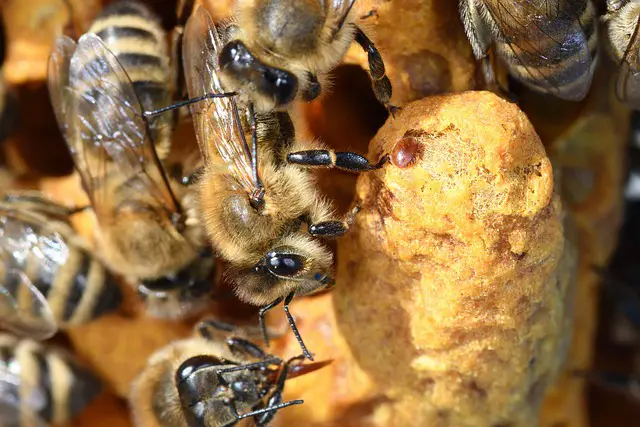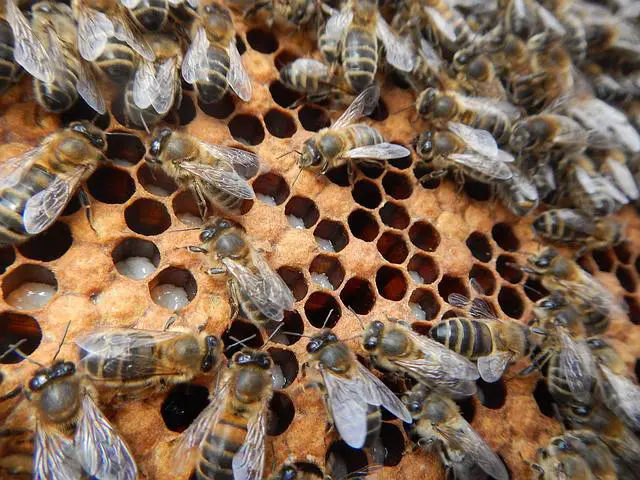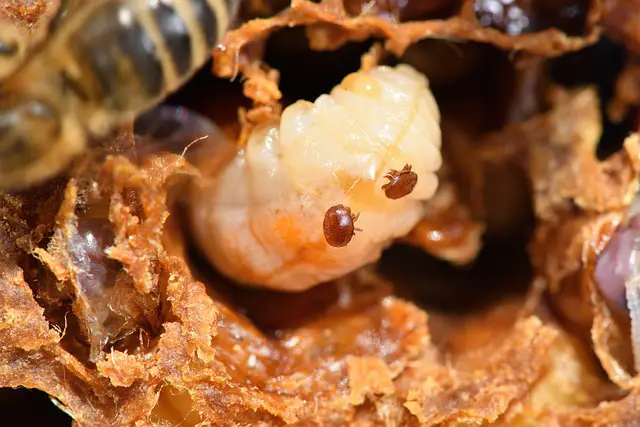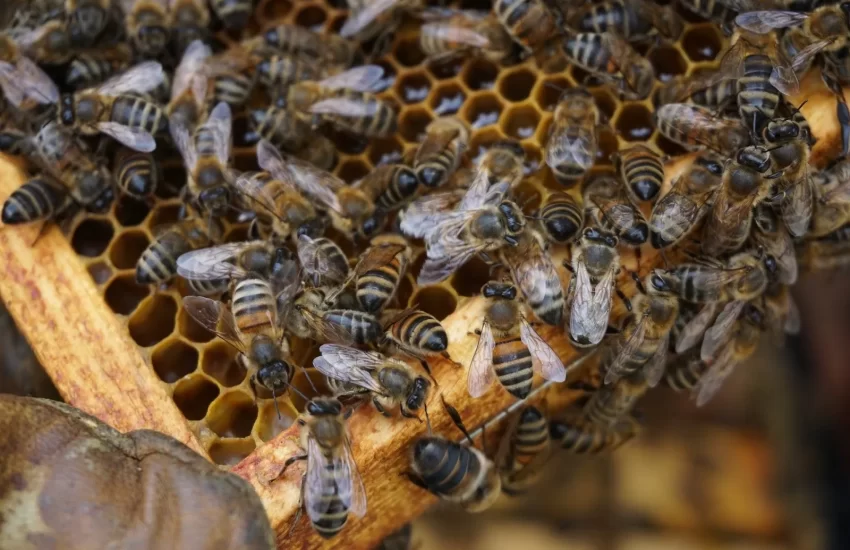Varroa Mite Treatment for Honey bees
Varroa mites (Varroa destructor) are one of the serious maladies in beekeeping that gives beekeepers sleepless nights. It is the most predominant pest in honey bee colonies over the world. Since its emergence in the USA, it has wiped out many bee colonies, including wild bees. As a beekeeper, it is essential to understand the Varroa mite and the available options for its control.
Similar Articles you may like to read –
When should you not inspect a beehive?
Will bees clean mold off frames?
Can ants destroy a beehive?
What animal kills bees?
What is a Varroa mite?
The mite resembles a tick and is approximately the size of a pinhead. Its reddish-brown body has a shiny appearance. It is larger comparing to other mites making it visible to the human eye. Varroa mites attack both adult bees and developing larvae. The adult varroa mite clings itself to the honey bee’s body and feeds on its fat body tissue causing considerable damage to the bees. Individual mites can be seen clinging to a bee honey bee’s body, mainly in the abdomen. The immature stages of the mite are found in the brood cells. They can be seen when the plagued brood cells are opened, and the brood is removed. The male mites are smaller than the female mites and are hardly seen since they dwell inside the brood cells.
Damage to Honey Bees
Varroa mites cause injury to bees through direct feeding. The female adult pierces a bee and feeds on it. Adult bees have some resistance and are only damaged if the infestation is severe. The female mites also lay eggs on the uncapped brood. If more than one female mite plague a brood cell, it results in decay and deformations.
These include deformed wings or shortened abdomen. Symptoms may not be seen if only a single mite infests a brood cell. However, the lifespan of the honey bees is shortened significantly. Damage to the bee’s exoskeleton may also cause or accelerate viral diseases. The mites also transfer viruses as they penetrate through the skin. If a beekeeper does not treat infected colonies, they die after two to three years. The presence of honey bees with deformed wings may indicate an advanced stage of heavy mite infestation.
The Varroa Life Cycle

A mated female varroa enters a cell containing a developing larva and lays eggs. The developing mites feed on bee pupae. Depending on the number, the mites may have no noticeable effect, may cause deformation, or kill it. Mature mites get out of the cell, cling to adult worker bees and feed on them. While the male mites die in the cell, the female continiues with the cycle by entering other developing brood cells.
Mites Detection in a Hive
It is impossible to know the level of infestation by mites in a colony by merely carrying a regular inspection. Therefore, it is essential to sample your beehives to estimate the level of infestation. Here are some of the ways you can apply.
Alcohol Wash Method
This method is the most effective for determining the varroa infestation level in your hive. It entails capturing and putting about half a cup of house bees in a jar, placing a disc of number 8 mesh on top and then adding alcohol to the jar. To ensure all the bees are covered you should roll the jar for a minute. The mites die and detach from the bees. Lastly, shake the jar well and empty the mites and alcohol in a place where you can count them. This test should be done away from the hive.
Sugar Shake Method
This is a perfect method if you don’t want to kill the honey bees. Instead of the alcohol, you use powdered sugar and roll it over to ensure the bees are well covered. Place the jar down and wait a few minutes for the mites to drop off. Shake the jar and empty the sugar and mites on the surface. Dissolve the sugar and count the mites. You should return the bees to the nest.
Drone Brood inspection
This method involves opening the drone brood cells, removing the larvae or pupae with forceps, and inspecting the mites’ presence. You must open 100-200 cells to assess the mite infestation level.
Sticky Board Method
This method depends on the mites that fall naturally from the honey bees to the bottom board of the hive. A beetle trap tray is coated with petroleum jelly or sprayed with vegetable oil to make it stick and placed at the back of the bottom board. After three days, you remove and count the mites. To get an average daily mite drop, you divide the total by three.
Varroa Mite Treatments on Honey Bees
Chemical Treatments
Chemical treatments are administered to a bee colony by putting plastic strips impregnated with the active chemical in the hive, making it convenient and easy to use. Although the chemical treatments have provided a high level of varroa mites control, the mites are increasingly developing resistance to the chemical. Here are some of the chemical treatments that are commonly used:
Apistan
Apistan was the first pesticide to be registered by EPA for varroa mite control. The active ingredient, fluvalinate, disrupts the nervous system of mites while it has low toxicity on bees. The plastic strips that mimic bookmarks are impregnated with active pesticides, which hang between hive frames outside the brood nest. Apistan controls varroa mites effectively (100%) if used properly. However, report shows that the mite is increasingly resisting the pesticide. Therefore, it is advisable to rotate it with other treatments to minimise resistance development on mites.
Apivar
Apivar uses the chemical amitraz and is relatively new for beekeepers controlling varroa mites. Mites have not yet developed resistance to it. Apivar does not leave residues on the bee products(honey, propolis, wax, or pollen). It helps to eliminate several successive generations of mites in the hive, which helps to reduce mites populations in a hive effectively. It is administered in hives in the form of strips; a single application involves two strips per brood chamber.
Checkmite
Checkmite is sold as a plastic strip impregnated with the active pesticide. It provides 100 % mite control when they come into contact with it. Like Apistan, the mites are increasingly developing resistance to it; therefore, it is advisable to rotate its use with other treatments. It is also used in the control of small hive beetles. It should be used as per label directions. The pesticide residues can accumulate in wax and become toxic to honey bees.
Bio- Pesticides
These are products derived from plant volatiles. Some of them have been accepted for controlling varroa mites in bee colonies. While they can be as effective as synthetic chemical pesticides, administration can be pretty different; hence a beekeeper needs to understand the differences.
Formic Acid
Formic acid is registered for varroa mite control in the USA. It is also allowed in organic honey production. Infact,It is the only permitted pesticide for the same. It is mainly administered in bee colonies by placing soaked pads with the pesticide on top of the hive. One of its downsides is that it cannot be used during nectar flow. It is also very corrosive and toxic to human beings.
Apilife Var
Apilife Var contains a mixture of thymol, eucalyptol, and menthol essential oils. EPA has approved it for both varroa and tracheal mites control in the USA. Its effectiveness in mites control is temperature-dependent ( From 600 F to 900 F). It is delivered into the beehive in the form of a vermiculite tablet. The tablet is divided into four pieces and set in the four corners of the hive. It should be wrapped in a wire mesh to prevent the bees from consuming or removing it from the hive before its completes its task. The treatment takes place in three weeks, and new tablets should be used weekly. Since it may cause the death of bee broods, it is primarily used in fall when brood rearing significantly declines.
More articles you may like to read –
What should I put under my bee hives?
What time of the day is best to move a hive?
What do bees do with dead bees in the hive?
Do snakes eat bees? Do birds eat bees?
Mechanical Methods

Hive Manipulation( Drone Trapping)
Varroa mite completes its development cycle by use of the brood cells. They prefer drone brood cells to workers’ brood. Empty frames that rear drone brood in them are introduced into the infested colony. A queen bee can be coaxed by providing full frames of drone brood cells. Two frames of worker brood are removed and replaced with empty frames. This will signal the queen to lay drone eggs. When the house bees seal the cells, the frames with mites trapped in the drone cells are removed and destroyed. With this method, you can ruin a lot of varroa mites at once. This gets their population to levels that a colony can naturally handle.
Use of Inert Dust
This method entails covering adult bees in the hive with fine dust particles, e.g. talc or powdered sugar. The fine particles cause the mites clinging to the bees to lose grip and fall off. While this method requires no chemicals, it can be laborious and disruptive to the colony.
Other Methods of Control
Getting Mite-tolerant Bees
Honey bees are evolving and gaining the ability to counter attacks by varroa mites through behavioral responses. The Russian bee stock is considered to have a higher resistance to varroa mites than other bee stocks. Survivor bees: those that have lived without chemicals for some years defend themselves aggressively against any intruder. Here is how they do it:
Uncapping and removing mite-infested pupae. Bees that possess such a trait are said to have varroa-sensitive hygiene. They are believed to identify such cells through the pupae emitting odor as mites feed on them.
The other trait bees use to get rid of mites is grooming behavior. Some bee stains are better at removing mites from their bodies than others. This behavior is also associated with mite-biting.
Cautions to Take for Beehive Treatments
You should avoid any treatment when honey supers are in the hive. The honey can become contaminated. You should only treat your colony only when it is necessary. Regular medications cause mites to build resistance.
FAQs
When should l carry out mite treatment operation for a newly installed hive?
The best time to treat for mites is when the colony doesnt have brood since they will not be hiding in the capped brood cells. After the new colony has settled in their new home, you should conduct a mite test and treat your colony if necessary.
What are the signs of Varroa mite infestation in a colony?
Some of the signs that your colony is under attack by Varroa mites include uneven brood pattern, larvae appear sunken at the bottom of the cell, presence of mites at the floorboard, and reduction in the honey bee population.



